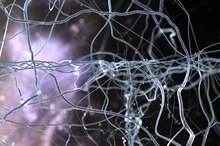What Is a Long-Chain Fatty Acid?
Fatty acids are composed of carbon atom chains with hydrogen atoms joined at one end and an acid group attached to the other. These are the major components in dietary fats or triglycerides. Fatty acids serve different purposes in the body, such as building cell membrane structure, producing energy or forming nerve cells. Long-chain fatty acids contain 20 or more carbon atoms.
EHA & DHA
Long-chain omega-3 fatty acids are separated into two types: eicosapentaenoic acid -- EPA -- and docosahexaenoic acid -- DHA. EPA is composed of 20 carbon atoms, while DHA contains 22. The human body cannot efficiently convert short-chain fatty acids to long chain, which is why it is important to consume foods with EPA and DHA. The main food source of omega-3 fatty acids is seafood, including salmon, mackerel, sardines, crustaceans, mollusks and squid.
Polyunsaturated Fatty Acids
Components of a Triglyceride
Learn More
Long-chain polyunsaturated fats are chains of carbon atoms with multiple double bonds. DHA and arachidonic acid -- ARA -- are the most abundant long-chain polyunsaturated fatty acids in the brain. Infants can obtain DHA and ARA through breast milk or supplemented formula, while adults and children get them primarily from seafood and eggs.
Saturated Fatty Acids
Long-chain saturated fatty acids are chains of carbon atoms that are fully saturated with hydrogen atoms. This creates straight and rigid chains, making saturated fats solid at room temperature. Sources of saturated fats in the diet include beef, pork, lamb, cheese, whole or reduced-fat milk and dairy products, palm oil, and coconut oil.
Health Effects
How Much EPA & DHA Are in Chia Seeds?
Learn More
Each type of long chain fatty acid has its own health effects. Omega-3 fatty acids help lower blood pressure, regulate mood and decrease the risk of heart attacks. Polyunsaturated fatty acids play a crucial role in brain and visual development, especially in infants. A study of infants published in the journal "Pediatrics" in 2001 found that exposure to higher levels of long-chain fatty acids along with longer durations of breast-feeding played a beneficial role in brain development. Saturated fats are associated with increasing levels of LDL cholesterol, but all saturated fatty acids are not created equal. A study published in 2010 in the "American Journal of Clinical Nutrition" found that stearic acid, a long-chain saturated fatty acid found in soybean oil, either decreased or had no effect on LDL cholesterol, while other saturated fats raised LDL cholesterol.
Related Articles
References
- Journal of Pediatric Gastroenterology and Nutrition: Role of Long-Chain Polyunsaturated Fatty Acids in the First Year of Life
- Circulation: Long-Chain Monounsaturated Fatty Acids and Incidence of Congestive Heart Failure in 2 Prospective Cohorts
- American Journal of Clinical Nutrition: Cardiovascular Disease Risk of Dietary Stearic Acid Compared With Trans, Other Saturated, and Unsaturated Fatty Acids: A Systematic Review
- University of Minnesota Extension: What's Up With Coconut Oil?
- Nutrients: Long-Chain Omega-3 Oils -- An Update on Sustainable Sources
- Pediatrics: Breastfeeding, Long-Chain Polyunsaturated Fatty Acids in Colostrum, and Infant Mental Development
- Today's Dietitian: The Role of DHA and ARA in Infant Nutrition and Neurodevelopmental Outcomes
- American Heart Association: Saturated Fats
Writer Bio
A registered dietitian, Emily Cooper has developed recipes and articles for Food and Nutrition Magazine, Encore Magazine, and the Vermont Peanut Butter Company. When she's not in the kitchen, you can find Emily hitting the streets for a run, or sharing her healthy-living tips on her blog, Sinful Nutrition.









